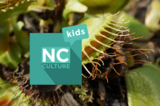
This parent guide supports parents in helping their child at home with the 6th grade Science content.
- Subject:
- Science
- Material Type:
- Reference Material
- Vocabulary
- Author:
- Kelly Rawlston
- Letoria Lewis
- Date Added:
- 10/11/2022

This parent guide supports parents in helping their child at home with the 6th grade Science content.

This resource accompanies our Rethink 6th Grade Science course. It includes ideas for use, ways to support exceptional children, ways to extend learning, digital resources and tools, tips for supporting English Language Learners and students with visual and hearing impairments. There are also ideas for offline learning.

Students will observe the growth of C-Fern plants under rather normal and abnormal conditions. They will then predict the reasons for any differences in tropic response.

This brief video lesson discusses how plants communicate through air-borne chemical cues. Discussion/assessment questions and suggested supplemental resources are also included.

This video demonstrates how corn seedlings behave in the presence of both gravity and a central light source in an otherwise dark room.

Students will identify gravitropism in plants (both negative and positive) and explain the siginificance of this adaptation to a germinating seed. Students will collect, graph, interpret and summarize data.

Examines different environments where seeds germinate or are dormant. Students read text, view video, and are provided with discussion questions.

Students will research a plant from around the world to see how it has evolved to survive in that specific habitat. This lesson was developed by Freddy Wang as part of their completion of the North Carolina Global Educator Digital Badge program. This lesson plan has been vetted at the local and state level for standards alignment, Global Education focus, and content accuracy.

Students will research a plant from around the world to see how it has evolved to survive in that specific habitat. This lesson was developed by Freddy Wang as part of their completion of the North Carolina Global Educator Digital Badge program. This lesson plan has been vetted at the local and state level for standards alignment, Global Education focus, and content accuracy.

Students will learn about different pollinators around the world. This lesson was developed by Freddy Wang as part of their completion of the North Carolina Global Educator Digital Badge program. This lesson plan has been vetted at the local and state level for standards alignment, Global Education focus, and content accuracy.

After pollination, seeds need to be scattered. We will talk about how plants will spread their seeds depending on their environment. This lesson was developed by Freddy Wang as part of their completion of the North Carolina Global Educator Digital Badge program. This lesson plan has been vetted at the local and state level for standards alignment, Global Education focus, and content accuracy.

Students will be familiarized with plant seeds, as well as the techniques used to make detailed observations about their phsyiology.

In this activity, students will investigate how well a tomato plant grows when placed in a planter upside down.

This content resource builds students' knowledge and conceptual understanding about plants through interactive activities, printable worksheets, and hands-on explorations. There are six investigation cases for students to complete; each case examines a different aspect of plant life, including plant structures, life cycles and reproduction, proper environmental conditions for growth, and ecological importance. Supplemental background information and a teacher's guide with suggestions for using the materials in the classroom are also provided. A Spanish version of the web site is available.

In this investigation, students consider whether there is a relationship between the number of spines on a holly leaf and its height above the ground.

In this lesson, students investigate the strong gravitropic response in dandelion flower stalks.

This project starter gives some ideas of ways that structural responses in plants can be explored.

In this activity, students make the root of a seedling grow through a maze by rotating a petri dish to different angles. When a seed germinates, a root and a shoot appear. Their directional movements are a response to gravity or gravitropism. Primary roots show positive gravitropism as they grow toward gravity.

In this short video, students learn how fire plays an important role in the survival of the plants (such as venus flytraps and longleaf pines) in the habitat of Carolina Beach State Park.

In this short video and accompanying activity and readings, students learn about the Venus Fly Trap and how it adapts to its environment to survive.